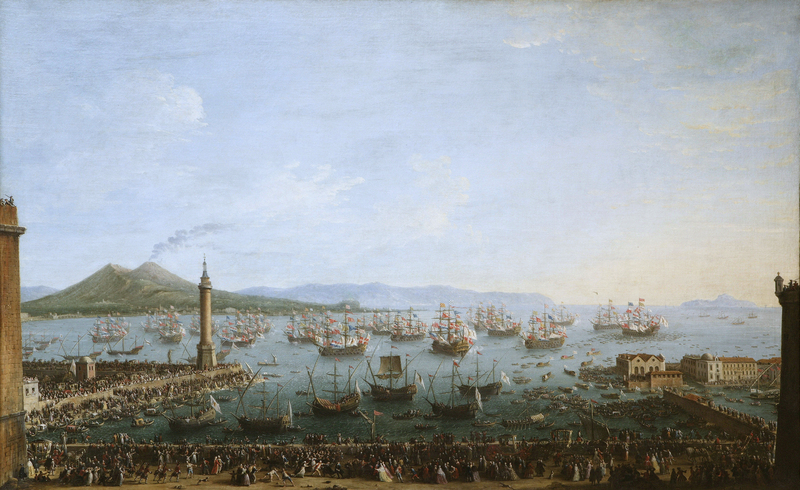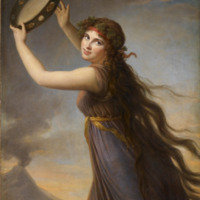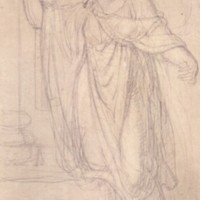Urban Life in Naples
The ascension of Charles VII (1716-1788) to the throne of both Naples and Sicily in 1734 resulted in a rejuvenation of Neapolitan art and nationalism through royal commissions from the king and his court. King Charles VII supervised the excavation of Herculaneum around 1738, nearly twenty years after its initial discovery in 1709.1 As with much of the rest of Europe, the discovery of Pompeii and Herculaneum sparked an interest in antiquity, and much of the art from Naples reflected that. In Departure of Charles III from Naples, painted by Antonio Joli (1700-1777) in 1759, the smoking Mount Vesuvius is visible in the background, past the bustling harbor and crowded bay. Under Charles VII, the Kingdom of Naples expanded and flourished into a thriving metropolis, the third largest in Europe after Paris and London.2
Often described as bright, delightful, or even “frolick and gay” by 18th-century traveler John Courtenay (1741-1816), Naples was the alluring city of colorful delights and surplus.34 Its citizens were able to enjoy cups of snow-flavored ice while basking in the sun and sweet Neapolitan languishing air. Despite the ubiquity of pickpockets and petty crimes, the atmosphere surrounding Naples was more sexually promiscuous than dangerous; instead of following the maxim, “choose one out of many for amorous play,” the Neapolitans preferred to discretely soften the rules, abiding by “change very often” instead.5
Along with sparking intellectual debates across almost every subject, including democracy, individual rights, and free-market economy, Naples was also known for its theatric traditions.6 The introduction and rise of opera (tragic, comic, and sacred) and dance (ballet and social) stemmed from the continual support from aristocratic patronage, conservatories, and performance venues.7 The influence of these arts were clearly visible through the lives of the people residing in Naples and the city itself. Emma Hamilton (1765-1815) was one such resident of Naples, who brought the paintings and sculptures from antiquity to life.8 Constantly dancing and posing in various costumes, Hamilton was a woman of charm and classical grace, despite her lower-class upbringing.9 During her stay in Naples, she was able to witness many objects excavated from Pompeii and Herculaneum, and learned to imitate the attitudes of the figures she saw, like the profiles on Sicilian coins and even Apollo Belvedere.10
JF
________
1 James Voorhies, “Art of the Seventeenth and Eighteenth Centuries in Naple,” Department of European Paintings, The Metropolitan Museum of Art, last modified October 2003, http://www.metmuseum.org/toah/hd/npls/hd_npls.htm
2 Anthony DelDonna, Opera, Theatrical Culture and Society in Late Eighteenth-Century Naples (New York: Routledge, 2012), 1.
3 John Courtenay, The present state of the manners, arts, and politics, of France and Italy; in a series of poetical epistles, From Paris, Rome, And Naples, In 1792 and 1793; addressed to Robert Jephson, Esq. By the Right Hon. John Courtenay, M. P. (Dublin, 1794), 75
4 Mariana Starke, Letters from Italy, between the years 1792 and 1798, containing a view of the revolutions in that country, from the capture of Nice by the French Republic to the expulsion of Pius VI. from the ecclesiastical state: Likewise pointing out The matchless Works of Art which still embellish Pisa, Florence, Siena, Rome, Naples, Bologna, Venice, & With Instructions For the Use of Invalids and Families Who may not choose to incur the Expence attendant upon travelling with a Courier (London, 1800), 75.
5 Courtenay, The present state of the matters, 75.
6 DelDonna, Opera, 2.
7 Ibid., 3.
8 Quintin Colville, "Emma Hamilton," BBC History Magazine, December 2016, 52.
9 John Cooper, curatorial statement, Emma Hamilton Dancing (Yale University: Lewis Walpole Library, 2013-2014), 3.
10 Cooper, Emma Hamilton Dancing, 11-12.


